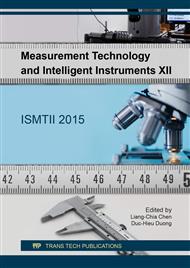p.21
p.27
p.34
p.41
p.47
p.53
p.61
p.67
p.73
Theory and Experiment Study on Laser Self-Mixing Interference with Multiway Feedback External Cavity
Abstract:
The self-mixing interference (SMI) effect with multiway feedback is analyzed in this paper. The basic theory of SMI with multiway feedback external cavity (MFEC) can be derived from the theory of interference as well as the theory of laser self-mixing interference (LSMI). Based on the external cavity structure with MFEC, a SMI model with two feedback external cavity structure is proposed. The expressions of the phase and output power in the MFEC are deduced and some simulation analyses are made. It is found that the output signal of the SMI system with two external cavity is sinusoidal or sawtooth waves, which is similar to the signal of SMI with a low frequency sinusoidal phase modulation. The density of interference signal fringes is uneven in one period and the shape of the interference wave is determined by the intensity of the external feedback. Furthermore, a SMI with two feedback external cavity experiment system is considered, and the experiment verifies the simulations.
Info:
Periodical:
Pages:
47-52
Citation:
Online since:
September 2017
Authors:
Price:
Сopyright:
© 2017 Trans Tech Publications Ltd. All Rights Reserved
Share:
Citation:


